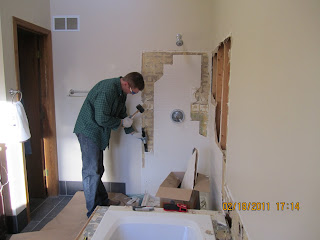The biggest project we have completed to date is the master bathroom. This room was most in need of an update because everything in the room was about 20 years old and the flooring was carpet. All the fixtures had chrome finishes and the vanity had a laminate counter top that was starting to peel apart. The one thing we loved about the master bath was the size. The original layout worked so we didn't need to do any major demolition or utility relocation. Our must haves for the renovated bathroom were:
-Heated Tile floor
-tiled shower base
-Double Vanity
-seamless glass shower
-rain shower head
-enclose entry way (future post)
Here are some before pictures:
Now for the renovation pics:
First step removing the old mirror, old vanity, carpet, and linoleum in the lav area:
After demo, I started by screwing down the original OSB board. Then I set the cement board in a layer of mortar. Before the mortar began to set, I screwed the cement board to the OSB base. After the cement board was installed I troweled on another layer of mortar on top of the cement board. Next the radiant floor heating was installed. I utilized a 3'x10' roll of Heated underlayment from Home Depot (
http://heatedunderlayment.com/index.html). This was honestly way easier to install then I ever thought it would be. The underlayment simply unrolled and fit perfectly from the shower to the beginning of the vanity. After the heating was placed on the mortar bed, tile was ready to be installed. Unfortunately I do not have any pictures of the heated underlayment.
I chose 8" x 24" porcelain tile from Florida Tile (
http://homeowners.floridatile.com/products/urbanite). This was the first floor tile I have ever installed so it took me longer than I imagined. I constantly had to check my installation with a 3' level. Tile spacers were also a huge help: Here are some pictures of the installed tile:
After the tile was installed I wired the heated flooring to an existing receptacle. I also had to install a thermostat to regulate the heated flooring. I simply fished the wire from the now blanked out receptacle to the thermostat. The wires from the underlayment were also fished to the thermostat. Then a quick square cut into the drywall, a little mud, and a few wire nuts and the job was finished.
Vanity: Kim and I decided to go with a double vanity. To save cost we purchased a travertine double bowl vanity from Overstock.com. It was considerably less then most of the vanities sold at bath or big box stores. The only problem was that it weighed over 450 pounds. Needless to say it took 4 people to transport it from the garage to the bathroom. Here is a picture of the vanity:


After the vanity was installed I went on to install a travertine backsplash. The backsplash was meant to match the vanity top. I chose a 2x2 mosaic from Florida Tile. This was by far the easiest tile to install. I troweled on a simple tile adhesive and pressed the 12"x12" pieces on the wall. The only thing I had to look out for was keeping the tiles straight both vertically and horizontally. After Installing the backsplash I purchased and installed two brush nickel mirrors and two brushed nickel faucets from Home Depot. The original plumbing did not have any shut off valves at the vanity so I went ahead and installed 4 compression fittings. The installation of the faucets was a learning experience. I won't lie I probably spent 20 hours installing them. I basically replaced all of the plumbing from the wall out. After all the installations here is the finished product:
My next post will include the shower and bath renovations. Thanks for reading!














































 Chair rail:
Chair rail:










